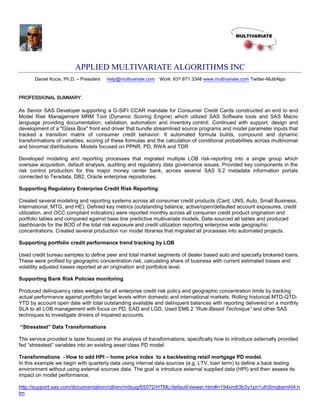
CCAR - Kocis
- 1. APPLIED MULTIVARIATE ALGORITHMS INC Daniel Kocis, Ph.D. – President help@multivariate.com Work: 631 871 3348 www.multivariate.com Twitter-MultiAlgo PROFESSIONAL SUMMARY: As Senior SAS Developer supporting a G-SIFI CCAR mandate for Consumer Credit Cards constructed an end to end Model Risk Management MRM Tool (Dynamic Scoring Engine) which utilized SAS Software tools and SAS Macro language providing documentation, validation, automation and inventory control. Continued with support, design and development of a "Glass Box" front end driver that bundle streamlined source programs and model parameter inputs that tracked a transition matrix of consumer credit behavior. It automated formula builds, compound and dynamic transformations of variables, scoring of these formulas and the calculation of conditional probabilities across multinomial and binomial distributions. Models focused on PPNR, PD, RWA and TDR Developed modeling and reporting processes that migrated multiple LOB risk-reporting into a single group which oversaw acquisition, default analysis, auditing and regulatory data governance issues. Provided key components in the risk control production for this major money center bank, across several SAS 9.2 metadata information portals connected to Teradata, DB2, Oracle enterprise repositories. Supporting Regulatory Enterprise Credit Risk Reporting Created several modeling and reporting systems across all consumer credit products (Card, UNS, Auto, Small Business, International, MTG, and HE). Defined key metrics (outstanding balance, active/open/defaulted account exposures, credit utilization, and OCC compliant indicators) were reported monthly across all consumer credit product origination and portfolio tables and compared against base line predictive multivariate models. Data-sourced all tables and produced dashboards for the BOD of the total risk exposure and credit utilization reporting enterprise wide geographic concentrations. Created several production run model libraries that migrated all processes into automated projects. Supporting portfolio credit performance trend tracking by LOB Used credit bureau samples to define peer and total market segments of dealer based auto and specialty brokered loans. These were profiled by geographic concentration risk, calculating share of business with current estimated losses and volatility adjusted losses reported at an origination and portfolios level. Supporting Bank Risk Policies monitoring Produced delinquency rates wedges for all enterprise credit risk policy and geographic concentration limits by tracking actual performance against portfolio target levels within domestic and international markets. Rolling historical MTD-QTD- YTD by account open date with total outstanding available and delinquent balances with reporting delivered on a monthly SLA to all LOB management with focus on PD, EAD and LGD. Used EM6.2 “Rule-Based Technique” and other SAS techniques to investigate drivers of impaired accounts. “Stresstest” Data Transformations The service provided is lazer focused on the analysis of transformations; specifically how to introduce externally provided fed “stresstest” variables into an existing asset class PD model. Transformations - How to add HPI – home price index to a backtesting retail mortgage PD model. In this example we begin with quarterly data using internal data sources (e.g. LTV, loan term) to define a back testing environment without using external sources data. The goal is introduce external supplied data (HPI) and then assess its impact on model performance. http://support.sas.com/documentation/cdl/en/mdsug/65072/HTML/default/viewer.htm#n194xndt3b3y1pn1ufc0mqbsmht4.h tm
- 2. Starting with an existing PD model, contemporaneous quarterly level HPI is added and its impact on model fit calculated. The exact process provided explores several basic TRANSFORMATION_FUNCTIONS ( ie LAG, QOQ) and then creates COMPOUND_TRANSFORMATION_FUNCTIONS. A key consideration is the time span of the existing data. I am differentiating the reporting requirements of the scenario (2014:Q4 – 2017:Q4) and focused on a back testing time span assumed to start 2006:Q1. While each portfolio is different, I want to point out that complex transformations shorten available records for model building. The TRANSFORMATION_FUNCTIONS shown here include LAG, CUM with COMPOUND_TRANFORMATION_FUNCTION of L1_CUM1 (Combined two or more TRANSFORMATION_FUNCTIONS (LAG and CUM) with a maximum dimension of 5. The idea is to demonstrate the ability to create and combine standard transformations. In this example we created 220 transformations and then applied them to a back testing data base ready for reporting. L1_HPI = lag1(HPI); CUM1_HPI = HPI; L1_CUM1_HPI = lag1(CUM1_HPI);
